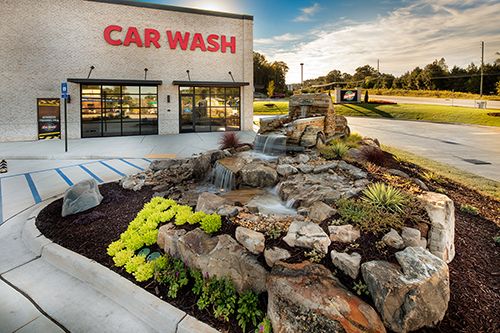
Fuel Positive First Impressions

By Tania Moffat
In the midst of a struggling economy, landscaping may be the last expense you want to invest in, but an aesthetically pleasing site can do more than fuel positive first impressions. Good landscaping can attract customers, accentuate your architecture and help build your brand message. If properly designed and maintained, the decision to landscape your property could become the smartest marketing decision you ever make.
Expert Advice
“Developing a solid design plan and hiring trained professionals are the two most important things to consider when beginning a new project,” says David Wright, president of Wright Landscape Services in Waterloo, Ontario. “First, whether you hire a landscape architect, designer or company, look to businesses that are part of your local or provincial landscape association. Secondly, having a solid idea of what you are getting yourself into helps you keep to a budget, envision the aesthetics, and determine how much maintenance will cost.”
In terms of new builds, Wright suggests owners look into what is required by the city or local government as landscaping is a legal requirement in some jurisdictions. When considering what to budget, he admits it is hard to give a definite number. “There are so many factors that go into the cost; one project could cost $3,000-$5,000 while another could exceed $60,000.”
Design Tips
“Do it right, spend the money at the outset and hire a reputable company,” echoes Winnipeg landscaper Keith Lemkey, from Lemkey Landscape Design. “Experts consider several factors when creating a design. Projects should balance mass, texture, and colour while considering plant survivability and site issues (like where snow is piled in the winter) to prevent future problems. Common pitfalls such as improper spacing come from inexperience and can require removing material or even restoring entire sections of the design when plants mature.”
To a trained designer, their choice of groundcover, hardscaping, pathways and lighting are just as critical to the project as the trees and plantings. Lemkey encourages people to discuss the pros and cons of different materials. “More plants mean more work, but choosing the right plants can mean the difference between having to prune monthly or yearly,” he adds.
Eight things to consider when developing your landscape design
- Make your entrance welcoming – Grab attention with seasonal flowers or planters.
- Consider seating – Do you have space for a bench or picnic table? Would your customers benefit from a place to stay for a cup of coffee or ice cream?
- Create interest - Use plant materials that can create a pleasing mix of texture, mass and colour.
- Plan traffic flow – Create paths and walkways and ensure plants are close enough or large enough to prevent manmade trails.
- Look to the future – Consider how your plants and trees will look at maturity? Can you wait for them to fill in, or should you buy more mature plants?
- Don’t be afraid to keep it simple – Less can be more. Let your design accentuate your architecture, not take over.
- Material matters – Consider the pros and cons of the plant and ground materials you will be using. e.g. How much pruning will a plant need?
- Bank on maintenance – Hire experienced landscapers for monthly and seasonal maintenance to keep your site looking its best for years to come.
Tania Moffat is a freelance writer, editor, publisher and photographer. She has worked in the publishing industry for the last 16 years on a wide variety of B2B and consumer publications, both in print and online. You can connect with her at info@chiccountrylife.com




































